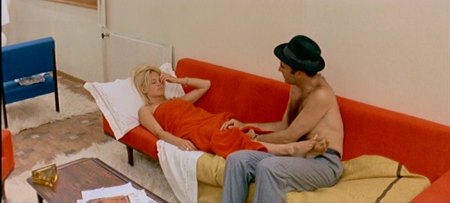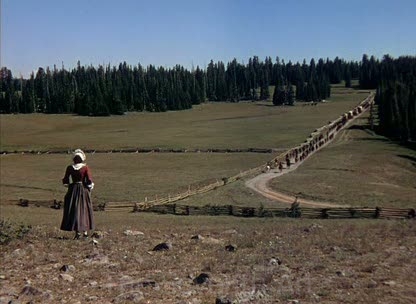Cabaret (Geoffrey Unsworth, 72)
The onslaught of Nazi think is personified on-stage, with Unsworth's unforgiving light and art director Tony Walton's bubbly, twisting mylar as backdrop. The film's off-stage moments are shot in a fuzzy, nostalgic haze...until the inevitable becomes evitable.
Carnal Knowledge (Giuseppe Rotunno, 71)
Rotunno's photography transmogrifies before our eyes, from classic 40s setups (in unusual widescreen) to slick 70s coldness.
Casablanca (Arthur Edeson, 43)
Romanticism in extrema.
Champion (Frank Planer, 49)
The hard-nosed early diagram for so many boxing movies.
Children of Men (Emannuel Lubeski, 2006)
Utilizing the then-new possibilities of digital photography, Lubezki revolutionizes the unbroken shot, while still keeping it gorgeous to witness.
Chinatown (John A. Alonzo [and Stanley Cortez], 74)
The noir film is given a jolt of color, always remaining true to its history.
Citizen Kane (Gregg Toland, 41)
The movie that taught us all. It taught us all.
City of God (Cesar Charlone, 2002)
A battleground use of color and perfect framing.
The City of Lost Children (Darius Khondji, 95)
Blues and yellows mix together, and end up in a greenish, fairy-taled, CGI-sickening hellhole.
Claire's Knee (Nestor Alamendros, 70)
As is the case with Eric Rohmer's works (for which Alamendros was a key player), the idyllic countryside becomes a metaphor for the female body.
Cleopatra (Victor Milner, 34)
A strikingly hued early De Mille spectacle, and an Oscar winner.
Cleopatra (Leon Shamroy, 63)
Dappled with light and hue, the long-masculine epic now becomes feminine.
Close Encounters of the Third Kind (Vilmos Zsigmond [with John Alonzo, William A. Fraker, Laszlo Kovacs, Steven Poster, and Douglas Slocombe], 77)
Special effects and lush photography--set against deserts, fields, mountains, houses, cities and space--unite for perhaps the first time.
Coal Miner’s Daughter (Ralf D. Bode, 80) '
The capture of both the rural and the less rural, in striking blues and browns.
The Color of Pomegranites (Suren Shakhbazyan, 68)
Shot after shot, you can hardly believe what you are seeing. Utterly unique in every way.
The Conformist (Vittorio Storaro, 70)
Stark, sharp angles and bold coloring accompany one man's decent into fascism.
Contempt (Raoul Coutard, 63)
Gorgeous primary-colored widescreen interiors and sharp exteriors highlight another of Coutard's indispensable collaborations with Godard.
The Cook, The Thief, His Wife and Her Lover (Sacha Vierny, 89)
Decadence and disgust, filmed with glory.
Every--and I mean every--shot is a stunner.
Cries and Whispers (Sven Nykvist, 73)
Ardent, elegant blood reds highlight this Oscar-winning turn from Bergman and Nykvist.
Crumb (Maryse Alberti, 94)
A prime example of expressive documentary cinematography.
Dancer in the Dark (Robby Muller, 2001)
Muller's faux-documentary style takes a leap with this schizophrenic melodrama that, in its musical sequences, utilizes the gaze of a hundred cameras.
Dark City (Dariusz Wolski, 98)
A wild, threatening dream world is made alive through Wolski's stunning camerawork.
Das Boot (Jost Vacano, 82)
Vacano's camera seeps in the harsh lighting and crushing claustrophobia of submarine life like no other movie has before or since.
Days of Heaven (Nestor Alamendros and Haskell Wexler, 78)
Arguably the most beautiful movie ever filmed; NOTE: my choice for the greatest cinematography of all time.
Dead Man (Robby Muller, 95)
The expressive influence of silent moviemakers in soaked up in Muller's work for this, one of the creepiest of westerns.
Dead Men Don’t Wear Plaid (Michael Chapman, 82)
Chapman perfectly matches the work of studio-era cameramen; his work can be seen side-by-side here with noir masters, without a hiccup.
Dead Ringers (Peter Suschitzsky, 88)
Suschitzsky's first in a long series of collaborations with Cronenberg, and perhaps his best; the film is filled with gloriously rich primary colors hauntingly tinted with the blackness of the film's tale. Plus, the film, pre-CGI, revolutionized the use of split screen photography in crafting the illusion of its twin leads.
Deep Red (Luigi Kuveiller, 75)
Kuveiller's camera jets from impossible close-ups to gorgeous long shots with a notable nimbleness.
Delicatessen (Darius Khondji, 91)
Stomach-churning yellows and greens vividly illustrate this cannibalistic, post-apocalypse landscape.
Zsigmond's camera sojourns so easily from idyllic weekend sightseeing to nightmarish frays.
Die Hard (Jan De Bont, 88)
Action photography at its most athletic and adept.
Double Indemnity (John Seitz, 44)
Through Billy Wilder's direction, Seitz's camera captures a man who;s already caught.
Dracula (Karl Freund, 31)
The undead, come to life, with creepy backgrounds and strong key lighting from German master Karl Freund.
Duel in the Sun (Lee Garmes, Ray Rennahan, and Hal Rosson, 46)
Bright yellows and reds memorably dapple this almost dreamlike tale of lust in the dust.
The Duelists (Frank Tidy, 77)
John Alcott's groundbreaking work with Barry Lyndon sees its closest compatriot in Tidy's expressive and absolutely transportative work.
The Diary of Anne Frank (William C. Mellor, 59)
The cinematographer had a bearish task here: how to deal with widescreen photography in a crushingly claustrophobic setting. Mellor--who'd been used to filming in wide-open spaces with John Ford's westerns--really challenged himself here, to astonishing effect.
Dick Tracy (Vittorio Storaro, 90)
The comic strip actually comes to vivid life under Storaro's tutelage.
The Diving Bell and The Butterfly (Janusz Kaminsky, 2007)
The masterful Janusz Kaminsky outdoes himself, with impossible images concocted in collusion with director Julian Schnabel's inventive guidance, to tell a story that many thought could not be portrayed on film.
Do The Right Thing (Ernest Dickerson, 89)
A red hot day in 80s Brooklyn is given a searing countenence. One of the most vivacious examples of cinematography out there.
The freezing, oppressive climate of revolutionary Russia is lit with the warm romanticism of an affair gone awry in this, another of director David Lean's jaw-dropping collaborations with the singular Freddie Young.
Down By Law (Robby Muller, 86)
The bayous, cityscapes and prison cells of New Orleans, in articulate blacks, whites and greys.
Drums Along the Mohawk (Ray Rennahan and Burt Glennon, 39)
A majestic early color cinematography Oscar winner, in service of director John Ford.


.jpg)
























.avi_snapshot_01.43.28_%5B2010.02.24_16.28.03%5D.jpg)















2 comments:
Really liking this series, when is the next one up?
Thanks! I've gotten a little sidetracked with my blog posts, while working on a long 100-segment series that I'm going to start posting soon. But I do need to get back to this series! E-F is about half-way done, and I'll make myself work on it some time next week!
Post a Comment